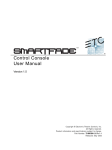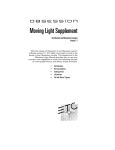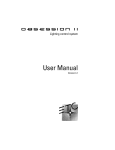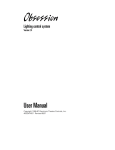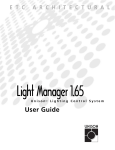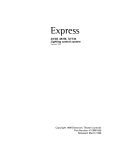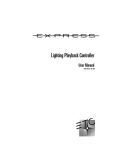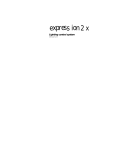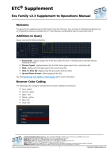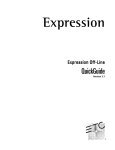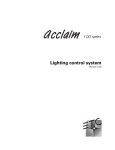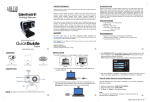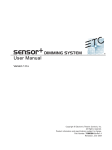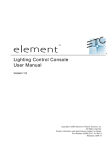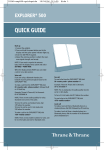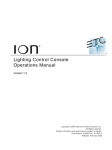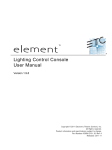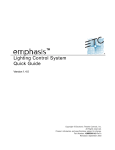Download Express LPC Quick Guide v3.1
Transcript
Lighting Playback Controller QuickGuide Version 3.1 ii Express Lighting Playback Controller QuickGuide Version 3.1 Contents Introduction . . . . . . . . . . . . . . . . . . . . . . . . . . . . . . . . . . . . . . . . . . . . . . . . . . .1 Getting started . . . . . . . . . . . . . . . . . . . . . . . . . . . . . . . . . . . . . . . . . . . . . . . . .2 Mounting the LPC . . . . . . . . . . . . . . . . . . . . . . . . . . . . . . . . . . . . . . . . . . . . . .2 Rack mounting . . . . . . . . . . . . . . . . . . . . . . . . . . . . . . . . . . . . . . . . . . . . . . . .3 Mount on a horizontal or along a vertical surface . . . . . . . . . . . . . . . . . . . . . .4 Mounting beneath a horizontal surface . . . . . . . . . . . . . . . . . . . . . . . . . . . . .4 Cabling . . . . . . . . . . . . . . . . . . . . . . . . . . . . . . . . . . . . . . . . . . . . . . . . . . . . . .5 Power supply . . . . . . . . . . . . . . . . . . . . . . . . . . . . . . . . . . . . . . . . . . . . . . . . .5 Dimmers . . . . . . . . . . . . . . . . . . . . . . . . . . . . . . . . . . . . . . . . . . . . . . . . . . . .5 Accessories . . . . . . . . . . . . . . . . . . . . . . . . . . . . . . . . . . . . . . . . . . . . . . . . . .5 Front panel . . . . . . . . . . . . . . . . . . . . . . . . . . . . . . . . . . . . . . . . . . . . . . . . . . . .6 Features . . . . . . . . . . . . . . . . . . . . . . . . . . . . . . . . . . . . . . . . . . . . . . . . . . . . .6 Producing shows for the Express LPC . . . . . . . . . . . . . . . . . . . . . . . . . .6 LPC operation . . . . . . . . . . . . . . . . . . . . . . . . . . . . . . . . . . . . . . . . . . . . . . . . .7 Reading a showfile . . . . . . . . . . . . . . . . . . . . . . . . . . . . . . . . . . . . . . . . . . . . .7 Macro control . . . . . . . . . . . . . . . . . . . . . . . . . . . . . . . . . . . . . . . . . . . . . . . . .7 Autocontrols . . . . . . . . . . . . . . . . . . . . . . . . . . . . . . . . . . . . . . . . . . . . . . . . . .8 Interfacing with external devices . . . . . . . . . . . . . . . . . . . . . . . . . . . . . .9 ETCNet . . . . . . . . . . . . . . . . . . . . . . . . . . . . . . . . . . . . . . . . . . . . . . . . . . . . . .9 Remote Trigger . . . . . . . . . . . . . . . . . . . . . . . . . . . . . . . . . . . . . . . . . . . . . . .9 MIDI Show Control / ETC MIDI . . . . . . . . . . . . . . . . . . . . . . . . . . . . . . . . . . .9 MIDI time code programs . . . . . . . . . . . . . . . . . . . . . . . . . . . . . . . . . . . . . .10 Printer . . . . . . . . . . . . . . . . . . . . . . . . . . . . . . . . . . . . . . . . . . . . . . . . . . . . . .10 Serial interface . . . . . . . . . . . . . . . . . . . . . . . . . . . . . . . . . . . . . . . . . . . . . .10 Setting the clock . . . . . . . . . . . . . . . . . . . . . . . . . . . . . . . . . . . . . . . . . . . . . .11 Using an RFU . . . . . . . . . . . . . . . . . . . . . . . . . . . . . . . . . . . . . . . . . . . . . . . .12 Using autocontrols . . . . . . . . . . . . . . . . . . . . . . . . . . . . . . . . . . . . . . . . . . . .12 Expression Off-Line . . . . . . . . . . . . . . . . . . . . . . . . . . . . . . . . . . . . . . . . . . .13 Upgrading software . . . . . . . . . . . . . . . . . . . . . . . . . . . . . . . . . . . . . . . . . . .13 Upgrading the LPC . . . . . . . . . . . . . . . . . . . . . . . . . . . . . . . . . . . . . . . . . . . .13 Upgrading remote interface devices . . . . . . . . . . . . . . . . . . . . . . . . . . . . . .14 Express LPC QuickGuide, v.3.1 iii Appendix A Specifications . . . . . . . . . . . . . . . . . . . . . . . . . . . . . . . . . . . . . . . . . . . . . . . .15 Appendix B Limited Warranty . . . . . . . . . . . . . . . . . . . . . . . . . . . . . . . . . . . . . . . . . . . . .19 Appendix C Declaration of Conformity . . . . . . . . . . . . . . . . . . . . . . . . . . . . . . . . . . . . .23 iv Introduction The ETC Express Lighting Playback Controller (LPC) is a playback system that provides complete, hands-off control of area lighting. It is ideal for environments where simplified control of lighting sequences and effects is needed. If more control capability is needed, the power of the Express LPC can be expanded by using it in a network or connecting it to external devices. For example: • MIDI Show Control (MSC) ~ Send and receive show control information using the MIDI Show Control protocol. • ETC MIDI ~ Control shows using this subset of MIDI. • MIDI Time Code (MTC) ~ Synchronize your show with external devices using the MIDI time code protocol. • ETCNet ~ Connect the LPC to an ETC network so that you can control or view remotely using remote interface devices. • Remote Macros ~ Start, stop and control shows with up to four external switches, for example on a door frame or operated by hand. • Remote Trigger ~ Provide switched control to an external device during LPC show operation. The LPC uses the proven design of the Express lighting console, a fullfeatured lighting controller used in thousands of educational and live performance centers. Working for you is the same complex show technology that made Express so popular, but in a simplified package. In fact, a show created for any console in the Expression line of consoles will run on the Express LPC. What you surrender in show creation, editing and control capabilities, you gain in ease of operation and simplicity. Express LPC QuickGuide, v.3.1 1 Getting started To use your Express LPC successfully, please follow the installation and operation instructions contained in this QuickGuide. In many places, these instructions rely upon additional information in the Express User Manual, which is supplied with the LPC. Shows to run in the Express LPC may be created in the console or in Expression Off-Line, a software program that emulates the programming capabilities of Expression-family consoles Following are the items contained in an LPC shipping package. The items marked with an asterisk (*) are not needed for all mounting positions. If anything is missing, or if you have questions about the installation or operation of the Express LPC, please call your dealer or ETC Technical Services at one of the offices listed on the back page of this document. • The LPC unit • LPC power supply and separate power cord • Two convertible front mounting brackets * • Two sliders and rear mounting brackets for a 19” rack * • Four rubber feet * • Mounting fasteners • This Express LPC QuickGuide, version 3.1 • Express User Manual, version 3.1 Mounting the LPC The LPC may be used without brackets securing it if the surface is sufficiently level and steady. All you need to do is attach the four rubber feet with the 4-40 x 3/8” screws, all provided with the LPC. Do not locate the LPC closer than six feet to dimmers or high-current AC lines to avoid electromagnetic interference. If you need to mount the LPC for stability or for operating convenience, hardware is supplied for each of the four mounting orientations listed below. The procedure to use for each mounting orientation is given next. 2 • In a 19” rack • Secured below a horizontal surface, such as a desk or shelf • Secured to the top of a horizontal surface • Secured to a vertical surface Getting started Rack mounting To mount the LPC in a 19” rack, follow the illustrated procedure below: 1. Remove all mounting hardware from the plastic bag. 2. Place one black washer on each of the eight 10-32 x 1/2” screws. 3. Attach the two L-brackets to the side panels of the LPC using three 6-32 x 1/4” flathead screws each. Choose the bracket holes that position the bracket flush with the front panel. 4. Secure the two rear brackets to the side panels of the LPC using two 6-32 x 1/4” flathead screws each, orienting the brackets as shown. 5. Fit the LPC through the front of the rack and position over the mounting holes. The L-brackets should be on the outside of the rack. 6. Secure the LPC to the front of the rack using four 10-32 x 1/2” screws and washers as shown. If the rack holes are not threaded, small black clips are provided for that purpose. Slide the black clips over the rack mounting holes and thread the screws into them. Caution: Keep the rear of the LPC supported to avoid bending the front brackets. 7. Using four 10-32 x 1/2” bolts (and threaded clips if necessary), attach the two slider brackets to rear holes in the rack that are opposite those holes used to mount the front of the LPC. Do not secure yet. 8. Line up the slider brackets with the rear brackets on each side of the LPC. The threaded studs on the rear bracket should fit into slider bracket slots. Attach each rear bracket to a slider using two 10-32 x 3/8” screws each. The screws go through slots in the brackets and into threaded slider bracket holes. 9. Secure all bolts so that the assembly is level and tight. Express LPC QuickGuide, v.3.1 3 Mount on a horizontal or along a vertical surface To mount the LPC either to the top of a horizontal surface or along a vertical surface, follow the illustrated procedure below: 1. Remove all mounting hardware from the plastic bag. 2. Securely attach the four rubber bumpers to threaded holes in the bottom of the LPC using 4-40 x 3/8” screws. 3. Securely attach the two L-brackets to the side panels of the LPC as shown, using two 6-32 x 1/4” flathead screws each. Choose the bracket holes closest to its bend. 4. Place the LPC on the surface where you want it. Mark the surface through the mounting holes in each bracket. Remove the LPC. 5. Drill holes at the marks. You will be providing the mounting screws (and anchors if necessary), so choose a drill bit accordingly. 6. Securely attach the LPC to the mounting surface. Mounting beneath a horizontal surface To mount the LPC to the bottom of a horizontal surface, follow the procedure below, with general reference to the illustration for top and vertical mounting above: 1. Remove all mounting hardware from the plastic bag. 2. Fasten the four rubber bumpers to the top surface of the LPC with double-sided tape (not included with LPC). 3. Securely attach the two L-brackets to the side panels of the LPC. The brackets should be flipped 180o from the bracket position shown in the illustration above, with the mounting flange facing the top. Choose the bracket holes farthest from its bend. 4. Place the LPC on the surface where you want it. Mark the surface through the mounting holes in each bracket. Remove the LPC. 5. Drill holes at the marks. You will be providing the mounting screws (and anchors if necessary), so choose a drill bit accordingly. 6. Securely attach the LPC to the mounting surface. 4 Mounting the LPC Cabling All connections to the LPC, except for the optional RFU, are made to the LPC’s rear panel. The numbers in the figure refer to items under Power Supply, below. Power supply 1. Push the LPC’s power switch to the off position (“O” symbol). 2. Remove the thumb screw to free the cable clamp from the rear panel. 3. The power supply has a cable attached to it. Clip the cable clamp over the cable near the 8-pin male connector. 4. Plug the connector into the LPC rear panel receptacle. 5. Adjust the cable clamp so that you can re-attach it to the LPC. 6. Plug one end of the furnished power cord into the power supply and the other end into a grounded power outlet.1 Dimmers Connect the dimmers as explained in the installation sections of your Express User Manual (Appendix A). Accessories If you are using a monitor, a Remote Focus Unit, a printer, ETCNet, MIDI or remote macros with your LPC, or if your show performs remote triggering, connect and install as explained in the installation sections of your Express User Manual (Appendix A). 1. The chassis may also be grounded, if needed, by placing a ground wire under this Phillips-head screw. Express LPC QuickGuide, v.3.1 5 Front panel The LPC’s front panel is shown in the illustration below. The numbers are keyed to the explanations of features below. Features The features of the LPC front panel are, from left to right: 1. The power-on indicator glows when the LPC is powered on. 2. Seven macro control buttons. Use these to control the LPC and the show. 3. Read From Disk button. Use this to read the show into the LPC. 4. Disk drive. 5. The fuse holder protects the LPC from an excessive power drain by the RFU, if attached. 6. RFU connector. Producing shows for the Express LPC Shows that run in the Express LPC may be produced in a couple of ways. One way is to develop the show in an ETC console that runs the same version of software as the LPC, such as an Express, Expression or Insight console. If the show is created in a console that has features not available in the LPC, such as a higher channel or dimmer count, the LPC responds only within the limits of its capabilities and ignores everything else. Another way to create a show for an Express LPC with ETC’s console emulator, Expression Off-Line, which runs on a pc-type computer. With Expression Off-Line you can produce a complete show that is tailored exactly for your particular LPC model.2 2. 6 See Expression Off-Line, page 13, for information about using Off-Line to create or edit LPC showfiles. Front panel LPC operation You need two things to run a show in an Express LPC: a diskette containing the show in console-ready form, and instructions about which macros available to the LPC were programmed into the show. The LPC clock may also be used in addition to macros to control the show, but clock control is not required.3 Reading a showfile Read showfiles by inserting a diskette in the LPC disk drive and pressing the Read From Disk button on the LPC’s front panel. If the showfile was prepared using system software older than version 3.03, everything in the showfile will be transferred at once to the LPC memory. If, however, the showfile was prepared with version 3.03 or later software, only the show components of the showfile will be transferred into memory. For those later showfiles, if you want to transfer the system configuration components into the LPC memory, press M7 on the LPC’s front panel while pressing the Read From Disk button. See the Showfile appendix in your Express User Manual for a breakdown of showfiles into show and system configuration components. Macro control Macros can control the LPC in three ways. Push button switches M1 through M7 on the LPC’s front panel can be used to activate macros 1 - 7. Up to four switches can be wired to a rear panel connector and used to activate macros 1901 - 1904. Used that way, those macros are known as Remote Macros. Finally, the LPC may be set to respond automatically to what is known as a Powerup Macro when the LPC is turned on. Any of the 2,000 macros possible can function as the Powerup Macro. For information about programming macros, including the Powerup macro, see the Macros chapter of your Express User Manual.4 Learn about programming remote macros in the Remote Interfaces chapter of your Express User Manual. For information about wiring the rear panel Remote Macro connector, see the Installation appendix of your Express User Manual. 3. See Setting the clock, page 11, for information about preparing the LPC for real time programs by setting the real time clock. 4. See your user manual for information about programming and setup operations. Express LPC QuickGuide, v.3.1 7 Autocontrols The front panel buttons, M1–M7 have programmable as well as fixed functions. Each can operate a macro in your show, as explained under Macro control, page 7. They may also be used in combinations to give you access to software displays and to make settings. When panel buttons, including the Read From Disk button, are used in non-programmable combinations, they are called autocontrols. Execute an autocontrol using the following 4-step procedure. 1. Press M7 and hold. 2. Press the additional button or buttons and hold. 3. Release M7. 4. Release the additional button or buttons. An Express LPC with version 3.1 system software contains the following autocontrols. Autocontrol buttons Function M7 / M1 M7 / (M1 and M2) M7 / M3 M7 / (M1 and M3) M7 / (M2 and M3) M7 / (M1 and M2 and M3) M7 / M4 M7 / (M1 and M5) M7 / (M5 and M6) M7 / (M1 and M6) M7 / (M2 and M6) M7 / (M3 and M6) M7 / (M4 and M6) M7 / (M1 and M5 and M6) M7 / (M2 and M5 and M6) M7 / (M3 and M5 and M6) M7 / (M4 and M5 and M6) M7 / (M1 and M2 and M3 and M4 and M5 and M6) Stage display Plus Patch display Enter Minus Clear Setup display Reboot Nothinga Softkey [S1]b Softkey [S2] Softkey [S3] Softkey [S4] Softkey [S5] Softkey [S6] Softkey [S7] Softkey [S8] M7 / Read From Disk Read system configuration Record a) Use this autocontrol to back out of an autocontrol operation without changing anything. b) The softkeys apply to the existing display, as viewed on your video monitor. 8 LPC operation Interfacing with external devices You can do more with your LPC if you use it to control or be controlled by external devices. Following are the ways you can operate the LPC with external devices and how you would go about implementing them. ETCNet The Express LPC supports ETCNet, a proprietary ETC network operating with Ethernet protocols, that allows you to operate a wide variety of ETC devices together. These devices can include ETC’s Remote Interface Units (RIU) or Remote Video Interface (RVI) devices. You can also use ETC’s newer interface devices, such as the ETCNet2 DMX Node or the ETCNet2 Video Node. Network interface devices can provide DMX512 outputs that mirror those of the LPC. They can also support remote monitors and alphanumeric keyboards that mimic those at the console and Remote Focus Units (RFUs) for remote control. Information about installing an RIU or RVI is available in the Reference appendix of your Express User Manual. Information about installing the newer ETCNet2 devices is given in their respective QuickGuides. To use ETCNet2 interface devices with an Express LPC, you must set the device to operate on ETCNet. See the Upgrade Software section in the Appendix of your Express User Manual for that procedure. Use unshielded twisted pair wiring (UTP) when making network connections between any interface device or network hub and the Express LPC.5 Remote Trigger If you are operating an external device that may be controlled by a switch closure, you can control that device with the LPC Remote Trigger feature. See the Installation appendix of your Express User Manual for an explanation about how to wire the LPC’s Remote Macro port for this purpose. Information about programming the Remote Trigger is found in the Control Interfaces chapter of your Express User Manual. MIDI Show Control / ETC MIDI See Chapter 24 Interfaces of your Express User Manual for information about using MSC and ETC MIDI. Connect the external MIDI device, such as a MIDI Sequencer, to the LPC’s MIDI “In” port. If any other device should receive the MIDI signal, connect the LPC’s MIDI “Thru” port to the “In” port of the second receiving device. If MIDI information will be generated within the LPC, such as to control the external MIDI device, run a cable from the LPC’s “Out” port to the “In” port of the external MIDI device. 5. Older Express LPC models also supported thinnet wiring, which is compatible only with RIU and RVI interface devices. If using an older Express LPC and thinnet, see the Installation Appendix of your Express User Manual for special information and information. Express LPC QuickGuide, v.3.1 9 MIDI time code programs The LPC can run programs that are timed according to the Musical Instrument Digital Interface protocol (MIDI). MIDI shows consist of a series of events containing cues, submasters or macros that play back at times determined by an external or an internal clock. To run a time code program in the LPC, load it in, connect a time code source and start the time code running. Refer to the Control interfaces chapter of your console user manual for detailed instructions about how to create and edit time code programs. The chapter also includes information about changing program loop time, frame rate and playing back a program by various means. To connect an external MIDI source, see Appendix A of your console user manual. Printer See Appendix A of your console user manual for information about attaching a printer to your LPC. Connect the printer to the LPC port labeled Parallel Printer. Information about printouts available from the Express LPC can be found in the Printing chapter of the Express User Manual. Serial interface On the rear panel of your LPC is a RS232 connector. This is reserved for a serial interface function that may be implemented later. It is not operational at this time. Please disregard option 13, Serial Protocol Baud Rate, on the Options Settings menu as well as the associated softkey, [S2], ESP Baud Rate, in that menu. The Options Settings menu is a choice on the Setup menu, which you may reach with autocontrol M7 / M4. 10 Interfacing with external devices Setting the clock If you plan to run real time programs from your LPC, you must first set the time and date configuration of its real time clock. If your real time program references sunrise or sunset, you must also set the astronomic functions of your real time clock (the astronomic clock). Latitude, longitude and time zone values for cities located around the globe are given in the Time and location appendix of the Express User Manual. You can set the time and date configuration of the LPC’s real time clock in either of two ways, both of which require you to attach a video monitor to the LPC. One way is to attach a Remote Focus Unit to the LPC. The second way is to take advantage of the LPC autocontrols. You can also set the astronomic clock when using an RFU, but not when using the LPC autocontrols. Astronomic clock settings, however, are needed only if your real time programs reference sunrise or sunset. If you need to set the LPC astronomic clock, you can perform those settings in either an Express console or in Expression Off-Line. They become part of the system configuration components which can then be read into the LPC from a showfile. See Reading a showfile, page 7, for information about reading a showfile’s system configuration components. NOTE: Clock settings are retained in LPC memory even if the power is temporarily removed. Once set, you should not need to reset the clock, but you may need to revise the setup later if, for example, power is removed for a long time or you need to set the astronomic clock. Express LPC QuickGuide, v.3.1 11 Using an RFU If attaching an RFU to your LPC to set the real time clock, follow the procedure below. 1. Connect the RFU and a video monitor to the respective ports on the LPC. 2. Use the M7/M4 autocontrol to go to the Setup display.6 3. Follow the procedure called Setting the Clock in the System settings chapter of your console user manual. Using autocontrols The LPC’s autocontrols allow you to perform all the configuration settings for the real time clock except provide data for the astronomical clock.6 In general, follow the procedures given under Setting the Clock in the System settings chapter of your console user manual except where required to choose from the Clock Functions menu. To make that choice, in the Express LPC, use the Plus or Minus autocontrols to move through menu selections. Use the Enter autocontrol to confirm your selection. For example, set the time and date in your LPC as follows: 1. Connect a video monitor to the LPC. 2. Use the M7/M4 autocontrol to go to the Setup display. 3. Press M7/M1 and M2 to step to selection #2 on the Clock Functions menu. You will see the following Time/Date display. NOTE: For any operations requiring the Plus or Minus autocontrol, you can repeat the function after first activating it by tapping the M7 key as many times as needed. 4. The time will be highlighted when you enter the display. To change it, press the Plus or Minus autocontrols to increment or decrement the time. When the minutes move past 60 or before 0, the hours increment or decrement, respectively. 5. Press the Enter autocontrol to move to the AM/PM field. Change by using the Plus or Minus autocontrols. 6. Continue with the rest of the settings in the Time/Date display using the Enter, Plus and Minus autocontrols as above. 7. When you are satisfied with the settings, press the Record autocontrol to start the clock. 6. 12 For a list of autocontrols, see Autocontrols, page 8. Setting the clock Expression Off-Line Shows for the Express LPC are often created in the same type of console for which the LPC is designed as a playback device. But you can also use ETC’s console emulator, Expression Off-Line, which runs on an IBMequivalent personal computer. Expression Off-Line reproduces virtually all of the functions of the LPC software using simulations of the same keys, controls and displays that you find on the console itself. When you create shows in Expression Off-Line, you are not constrained by the lack of a label key and alphanumeric keyboard as is true for an Express console. Not only can you create shows in Off-Line but you can also use Off-Line to label things, such as real time programs, cues, groups and channels. Labels attached in Off-Line stay with the show when transferred to the Express LPC, where you can view them with an attached video monitor. Instructions for labeling in Expression Off-Line are given in the Expression Off-Line QuickGuide. Off-Line and its QuickGuide may be obtained without charge from your dealer, from the ETC website at www.etcconnect.com or from ETC Technical Services. Information about reaching ETC Technical Services at several sites around the world is given on the back page of this document. Upgrading software Upgrading software in your Express LPC is analogous to upgrading software in an Express console. You can also use the LPC to upgrade the software of any remote interface devices connected to the LPC and set its network configuration. The procedure for upgrading software in your LPC is the same procedure given under Upgrading software in Appendix A of your console user manual, with a few exceptions. These are noted below. Upgrading the LPC • • Setup display ~ Step 5 of the procedure recommends that you verify the upgrade in the Setup display. In the LPC, execute the autocontrol for the Setup display (M7 / M4). Reset System ~ Step 6 requires you to reset the system after the upgrade. To reset the system in the LPC, follow the procedure below. 1. Go to the LPC Setup display if you’re not already there (see above). 2. Activate the Plus autocontrol (M7 / (M1 and M2)). Tap M7 three more times to get to the Clear Functions choice on the Setup menu. 3. In the Clear Functions display, execute the autocontrol for softkey S1 (M7 / (M1 and M6)). 4. Confirm the reset by executing the autocontrol for Enter (M7 / (M1 and M3)). Express LPC QuickGuide, v.3.1 13 Upgrading remote interface devices • • • • Crossed wiring ~ Sometimes when you’re using twisted pair wiring, a remote interface device does not appear on the Remote Units list. The cause could be crossed wiring. This problem is covered in the Upgrade software section of the console user manual under Devices missing from the list. To swap the wiring in the LPC, execute the autocontrol for softkey S6 (M7 / (M2 and M5 and M6)). Setting the configuration ~ You may be unable to communicate with one or more ETCNet 2 remote interface devices because they are configured for an ETCNet2 network. This problem is covered in the Upgrade software section of the console user manual under Devices missing from the Remote Units list. To set the network configuration in all ETCNet2 remote interface devices to ETCNet, execute the autocontrol for softkey S5 (M7 / (M1 and M5 and M6)). Upgrade all units ~ To upgrade all remote interface devices at once, execute the autocontrol for softkey S1 (M7 / (M1 and M6)). Upgrade some units ~ To upgrade some units, follow the procedure below: 1. Use the Plus or Minus autocontrols to move forward or backward through the Remote Units list. 2. While highlighting a unit you wish to upgrade, execute the autocontrol for softkey S8 (M7 / (M1 and M6)) to mark the unit. 3. Repeat step 2 to mark as many units as you wish. 4. After marking, execute the autocontrol for softkey S2 (M7 / (M2 and M6)) to upgrade the marked units. • Upgrade only one unit ~ Follow the procedure below: 1. Use the Plus or Minus autocontrols to move forward or backward through the Remote Units list. 2. While highlighting the unit you wish to upgrade, execute the autocontrol for softkey S3 (M7 / (M3 and M6)) to upgrade the unit. 14 Upgrading software Appendix A Specifications Electrical • • Voltage input 100-240 VAC, 50-60 Hz Maximum current 0.8 amps Built-in interfaces • • • • • • • • • 1,024 DMX512 outputs Parallel printer RS-232C serial port Remote Focus Unit Supports CE dimming systems Remote Macro control Remote Trigger option MIDI time code control ETCLink System capacity • • • • • • • • • • 600 cues per show 96, 192 or 250 control channels Proportional patching of up to 1,024 DMX512 dimmers Eight-part multipart cues Thirty-three dimmer profiles, all but one of which are editable 500 groups 99 focus points 2,000 macros 24 overlapping submasters Ten pages of submaster memory Playback controls • Seven front panel push-buttons Timed control • • • • Internal or external clock 12-hour or 24-hour timing References sunrise and sunset with astronomical clock Up to 500 user-created, Real Time Programs Display functions • • • • • • • • • • • Express LPC QuickGuide, v.3.1 VGA video output Stage Blind Fader Effects Spreadsheets: Cues, Submasters, Groups and Focus Points Patch Park Setup Flexichannel (displays only recorded channels) Channel attributes 15 Submaster functions • • • • • • • • • • • Ten pages of 24 recorded submasters each Fully overlapping channel assignments Proportional channel levels Programmable fade and wait times Live and programmed rate control Submasters either overlapping pile-on or inhibitive All submasters programmable with effects Update function Control keypad features Spreadsheet editing Submaster list Channel functions • • • • • • • • 8-bit and 16-bit data types Both highest level (Highest Takes Precedence) and last action (Latest Takes Precedence) channel types Group function to allow channels to be manipulated as proportionally balanced groups [And], [Except], [Only], and [Thru] functions to select [Full] function [Level] sets a channel to a user-selectable default value Independent channels Flip channel Moving light functions • • • • • Fixture personalities load from diskette Patch fixtures by assigning personalities, starting channels, starting DMX512 address, remote dimmer, swap focus, pan or tilt flip Five attribute categories Fixture box level adjustment Fixture focus with Solo Cue functions • • • • • • • • • • • • • • Up to 600 cues in the range 0.1 to 999.9 Discrete upfade and downfade times (00:00-99:59) for each cue Linked cue sequences Effect cues Split wait times Follow time Link to cue or macro Eight-part multipart cues Selective cue recording Update cue command Attribute range editing Subroutines, with cue or style steps Spreadsheet editing Cue list Group functions • • • • 16 Up to 500 groups Any cue or submaster may be accessed as a group Spreadsheet editing Group list Appendix A Specifications Focus point functions • • • • • • • up to 99 preset focus points Update cues and submasters when focus point changes Record level of focus point without link Available in effects Printout available Spreadsheet editing Focus point list Diskette functions • • • • 3.5-inch high-density diskette drive for show storage One show per disk Software updates installed through diskette drive Retrieve show and configuration contents separately or together Macro functions • • • • • • • • • • • Seven front panel push-button macro controls Up to 2,000 macro selections for programming Macros may activate any control sequence Live Learn mode Macro editing Macros programmable for Macro wait Can include in real time programs Can include in time code events Four macros operated by remote switches Powerup macro Remote Trigger function Effects functions • • • • • • • • • • • Effects may be recorded as cues or submasters Up to 100 steps each Live effects recording Spreadsheet editing 8-bit and 16-bit data types Variability of rate during playback Step times In/Dwell/Out Step fade times High/Low Levels In/Dwell/Out Effect fade times Range editing of effect attributes and step values Profile functions • • • Profiles may be assigned to dimmers Ten preset profiles, nine of which are editable Twenty-three additional profiles that may be programmed Options • • • • Express LPC QuickGuide, v.3.1 Parallel printer Remote Focus Unit Remote Macro controls Remote interface devices 17 18 Appendix A Specifications Appendix B Limited Warranty Electronic Theatre Controls, Inc. (ETC™) warrants to the original owner or retail customer (Customer) that during the warranty period ETC will repair or replace its products that are defective in materials or workmanship under normal use and service, subject to the terms of this limited warranty. The warranty period shall begin on the date of delivery of a portable system or on the date of energization of a permanently installed system, and shall continue for the following periods: (a) one year, for all Irideon products, and (b) two years, for all other ETC products. Warranty is limited to (60) days from shipment for purchase of demo or loaner products. Warranty does not cover any product or part of a product subject to accident, negligence, alteration, abuse or misuse, or any accessories or parts not supplied by ETC. Warranty does not cover “consumable” parts such as fuses, lamps, color media or components warranted directly to the owner by the original manufacturer. ETC’s warranty does not extend to items not manufactured by us. Freight terms on warranty repairs are FOB ETC factory or designated repair facility. Collect shipments or freight allowances will not be accepted. ETC’s sole responsibility under this warranty shall be to repair or replace at ETC’s option such parts as shall be determined to be defective on ETC’s inspection. ETC will not assume any responsibility for any labor expended or materials used to repair any equipment without ETC’s prior written authorization. ETC SHALL NOT BE RESPONSIBLE FOR ANY INCIDENTAL, GENERAL OR CONSEQUENTIAL DAMAGES, DAMAGES TO PROPERTY, DAMAGES FOR LOSS OF USE, TIME, PROFITS OR INCOME, OR ANY OTHER DAMAGES. The customer’s obligations during the warranty period under this warranty are to notify ETC at ETC’s address within one week of any suspected defect, and to return the goods prepaid to ETC at their factory or authorized service center. Express LPC QuickGuide, v.3.1 THIS WARRANTY IS CONTINGENT ON THE CUSTOMER’S FULL AND TIMELY COMPLIANCE WITH THE TERMS OF PAYMENT SET FORTH IN THE “TERMS AND CONDITIONS.” THIS WARRANTY IS EXPRESSLY IN LIEU OF ANY AND ALL OTHER WARRANTIES EXPRESSED OR IMPLIED, INCLUDING THE WARRANTIES OF MERCHANTABILITY AND FITNESS FOR A PARTICULAR PURPOSE AND OF OTHER OBLIGATIONS AND LIABILITIES ON OUR PART. THE CUSTOMER ACKNOWLEDGES THAT NO OTHER REPRESENTATIONS WERE MADE TO HIM OR RELIED UPON BY HIM WITH RESPECT TO THE QUALITY AND FUNCTION OF THE GOODS SOLD. This written warranty is intended as a complete and exclusive statement of the terms thereof. Prior dealings or trade usage shall not be relevant to modify, explain or vary this warranty. Acceptance of, or acquiescing in, a course of performance under this warranty shall not modify the meaning of this agreement even though either party has knowledge of the performance and a chance to object. Terms and Conditions The following terms and conditions, and those on the face hereof, shall control as to any order accepted by Electronic Theatre Controls, Inc. (ETC), notwithstanding any terms and conditions that may be contained in any purchase order or other document of Customer, and ETC’s acceptance of any order is expressly made conditional on Customer’s assent to such terms and conditions. Such terms and conditions will constitute the entire agreement between the parties as to any order and will supersede any prior understandings, agreements, representations, or warranties. Such terms and conditions will not be modified, added to, superseded or otherwise altered except by written document signed by an authorized representative of ETC, notwithstanding any terms and conditions contained in the purchase order or other document of Customer. ETC’s commencement of performance and/or delivery shall not constitute a waiver of these terms and conditions or any acceptance of any terms and conditions contained in the Customer’s order or other 19 documents. Acceptance of any product or service by the Customer will be construed as acceptance of ETC’s terms and conditions. Any dispute or questions of construction with respect to any order placed with ETC shall be governed by the laws of the State of Wisconsin. All prices are in US Dollars, FOB ETC’s factory or warehouse. Prices, models and specifications are subject to change without notice. Orders must be in writing. Phone orders will be accepted from established accounts when followed by written confirmation. The acceptance of any order does not imply conformance with plans and specifications unless the plans and specifications accompany the order and are accepted as binding by ETC. Equipment ordered which differs in any way from our standard catalog items will require drawings approved in writing by the Customer. When drawings are approved, they shall take precedence over all other written or verbal instructions. Orders are effective only when accepted and acknowledged by the factory. Minimum order is $25.00 net, exclusive of freight. Price protection will be given on orders entered for immediate shipment and for project orders entered before the effective date of a price increase. All other orders will be billed at the current price at time of shipment. Quotations for custom products are valid for thirty (30) days. ETC will attempt to ship goods for delivery on or about the times stated on the reverse side hereof, although time shall not be the essence in this contract. ETC will attempt to follow customer’s written instructions as to mode and routing of shipments. In absence of such instructions, ETC shall have absolute discretion as to mode and routing of shipments, including express or parcel post for small shipments. Where the customer has requested expedited freight, the customer will be responsible for the incurred additional charges. ETC shall not be liable for late delivery and/ or inability to perform due to unforeseen circumstances or conditions, including our ability to obtain supplies and raw materials, government regulations, labor stoppages, casualties, fire, and other causes beyond our control. When such circumstances or 20 conditions have been remedied, ETC will make and Customer will accept delivery/ performance. Equipment is shipped at the Customer’s risk and our obligation to deliver equipment is discharged upon their delivery in good condition to the carrier. Shipments are FOB ETC factory or warehouse. ETC will prepay and bill freight on UPS shipments. Freight and air are sent collect unless specifically quoted otherwise. Unless specifically prohibited, partial shipments will be made. Federal, state and/or local taxes, duties and other charges are the responsibility of the purchaser. Any changes in engineering drawings, specifications, or in other terms of manufacture, assembly or shipment, requested by customer, must be in writing and approved by ETC. If any such change by Customer causes an increase in the cost of, or in the time required for performance of, any part of the contract, then ETC shall make a reasonable adjustment to the price of the goods. If purchaser cancels any portion of a Purchase Order prior to shipment, Purchaser shall be liable to ETC for a cancellation charge equal to ETC’s actual costs incurred in connection with that portion of the Purchase Order that is cancelled, including, without limitation, labor and materials. Customer represents that it is solvent. ETC retains a security interest in the goods to secure payment of the purchase price and all other indebtedness now or hereafter owed by the customer to ETC. At ETC’s request, customer will execute a financing statement or statements evidencing such security interest and will take any other action necessary to perfect the same. Payment terms are net 30 days after date of invoice. If ETC in good faith doubts customers ability or willingness to pay, ETC may in its discretion complete its performance of this contract upon a cash in advance basis or make deliveries only upon a C.O.D. basis or file a UCC filing or suspend all or part of its performance here under. All payments are applied to the oldest outstanding invoice. Accounts over thirty (30) days are subject to a 1 1/2% (one and one-half percent) per month late payment penalty. ETC will have the option Appendix B Limited Warranty of withholding performance under any and all orders from the Customer if an invoice remains unpaid after 30 days. All disputes otherwise unresolved between ETC and Customer shall be resolved in a court of competent jurisdiction in the location of ETC’s offices, Dane County, Wisconsin. If suit or action is instituted by ETC to enforce payment or performance by the Customer, the Customer agrees to pay all costs and attorney’s fees incurred. Claims for shortage or damaged goods must be made within ten (10) days. Equipment is carefully packed and delivered in good condition to the carrier. All claims for loss or damage in transit must be made by the consignee directly to the carrier. ETC will render every aid and assistance in the presentation and enforcement of such claims without waiver of our rights to have compliance with the terms of payment of our invoices. Equipment returned without ETC’s written permission will not be accepted. Equipment returned for credit must be in accordance with established RMA procedures. Equipment must be unused, in original cartons and in saleable condition, subject to ETC’s quality control and test inspection. Restocking charges of $25.00 or 25% of invoice (whichever is greater) plus any repacking or reconditioning costs will be deducted from the credit. Returns for warranty work will be via warranty procedures. In no case will permission be granted to return specially-modified or custom equipment, or merchandise invoiced more than six (6) months prior to date of Customer’s return request. Express LPC QuickGuide, v.3.1 No failure of ETC to insist upon or compel compliance by the customer with any of these terms and conditions shall be constructed as a waiver by ETC of its right to insist upon compliance. No waiver by ETC of any breach by customer shall be effective unless in writing signed by ETC, and no waiver by ETC of any breach by customer shall be deemed a waiver of any other breach. If ETC shall fail to repair or replace defective goods within a reasonable time after they are returned to ETC, or if ETC shall wrongfully fail to make delivery or shall wrongfully repudiate this contract, then customer shall be entitled to recover from ETC such part of the purchase price as has been paid by customer to ETC. The remedy stated in the preceding sentence shall be customer’s exclusive remedy for any breach, non delivery, or repudiation by ETC or for any other liability of ETC to customer. This exclusive remedy shall not be deemed to have failed its essential purpose so long as ETC is willing and able to repair or replace defective parts in the prescribed manner. 21 22 Appendix B Limited Warranty Appendix C Declaration of Conformity Express LPC QuickGuide, v.3.1 23 Americas Middleton, Wisconsin • USA • Tel: (+1) 608 831 4116 • Fax: (+1) 608 836 1736 • (+1) 800 775 4382 • [email protected] Europe London • England • Tel: +44 (0)20 8896 1000 • Fax: +44 (0)20 8896 2000 • [email protected] Asia Hong Kong • Tel: (+852) 2799 1220 • Fax: (+852) 2799 9325 • [email protected] International 3030 Laura Lane • Middleton, Wisconsin 53562 • Tel: (+1) 608 831 4116 • Fax: (+1) 608 836 1736 • www.etcconnect.com 4110M1011 • Rev B • Released 6/01 Copyright © 2001 Electronic Theatre Controls, Inc. All Rights Reserved. Product information and specifications subject to change.































